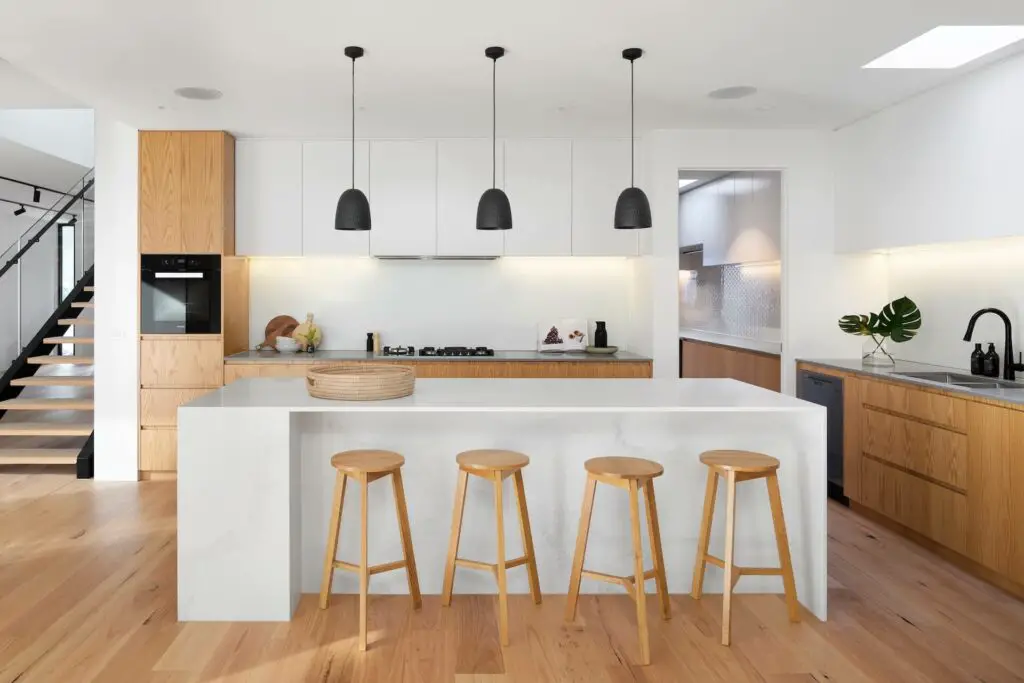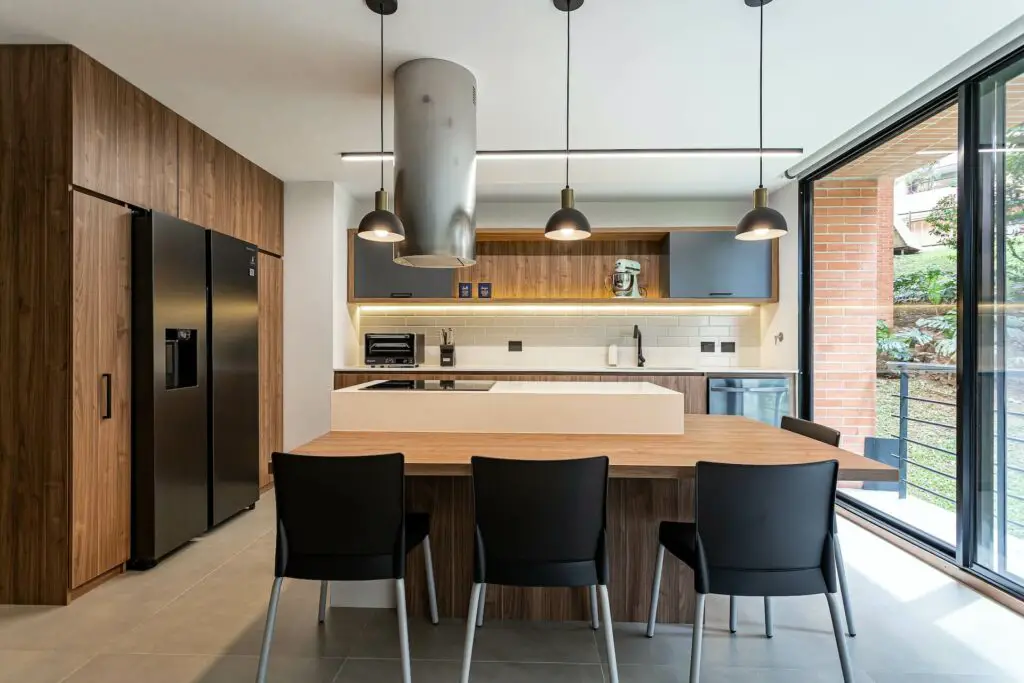Wall sconces are considered by some dated. Others, however, swear by them and always try to fit them in somewhere. I’m kind of in the middle. Sometimes they can look amazing but sometimes they are a bit tacky.
Let’s see if kitchen sconces are worth it and how they can match the rest of your kitchen lighting and style.
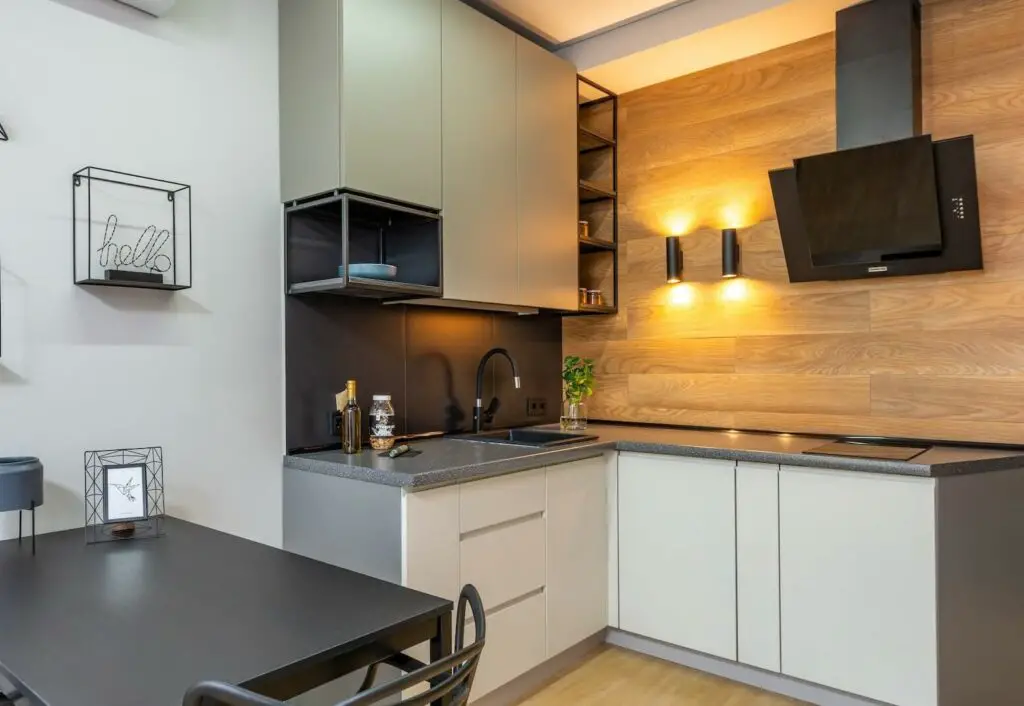
Kitchen sconces are a very interesting choice, especially if you are out of other options such as ceiling lights and LED strips. In general, sconces fit better in hallways, bathrooms, and the bedside. But in the kitchen, they can look great over the sink or next to a window. Try to leave some empty wall space around them, and choose wall sconces that match the rest of the kitchen’s style.
Where to put kitchen sconces
Wall sconces can be used either for ambient or task lighting. However, the kitchen’s ambient light is usually covered by chandeliers, recessed can lights, and (semi) flush mounts, while task lighting is achieved by pendants and LED strips under the cabinets.
To be precise, kitchen walls are usually covered by cupboards, counters, and cabinets. This is why sconces might be a bit redundant in kitchens or there might not be enough space for them.
For this reason, the two best positions for sconces are over the kitchen sink and next to a window. It’s likely that the wall is empty there.
Kitchen sconces should be placed around eye level to avoid annoying glares and make them feel natural. If the household members have very different heights, keep in mind that sconces might not be the best option for you.
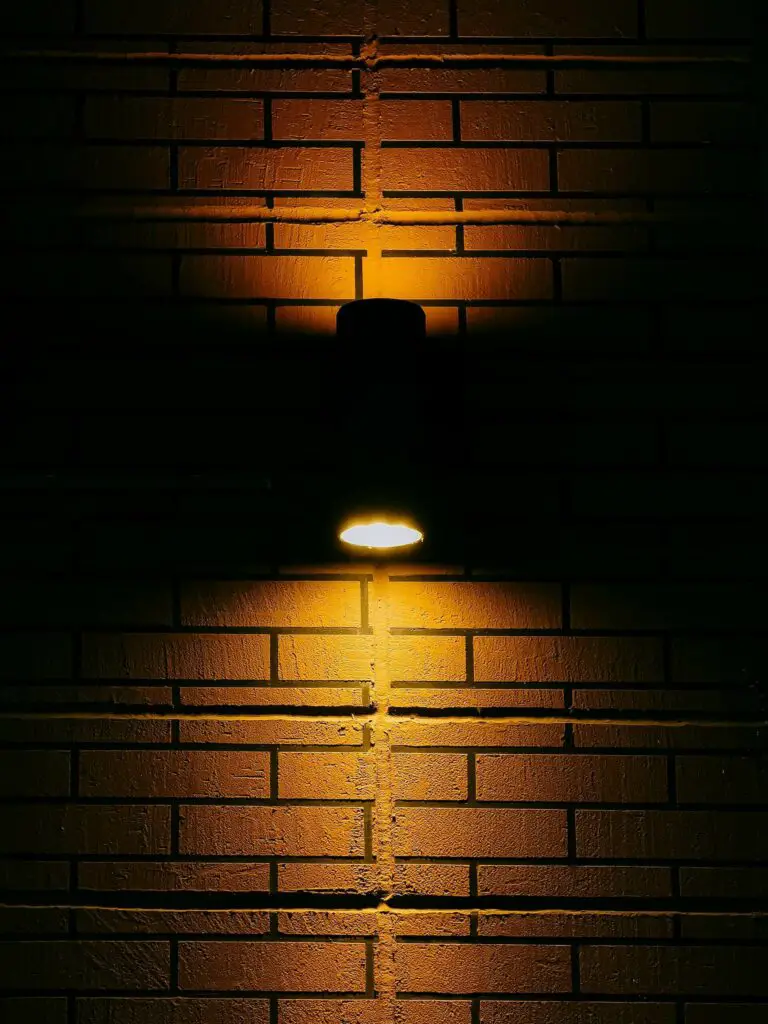
Now, you definitely don’t want your eyes to meet the bulb, so uplighters can be placed a bit higher than eye level (which also gives a nice glow to the ceiling), whereas downlighters can be placed a bit further below, which makes them excellent for task lighting (cooking, etc.).
Sconces that diffuse light 360° are best for the outdoors, like a patio or a garden, and on the sides of the mirror.
Now you know where to place them. Let’s see 5 awesome tips that will make sure you have the nicest sconce setup possible!
1. Diversify your light sources
Wall sconces in the kitchen always draw attention, even if they’re not lit.
If you rely on them too much, your kitchen might look dull. It might even look like you tried to find an easy way out of proper lighting.
So what exactly does it mean to diversify your light sources?
Well, use as many fixtures as you can while making sure that every area of the kitchen is lit appropriately (and sufficiently!).
Remember: Ambient light is needed for general stuff – just to be able to see the room. Task lighting is needed in specific small areas where you do certain things, such as chopping yo veggies. Accent lighting makes the space A LOT more dramatic and interesting. Strive for a perfect balance of all three.
How to diversify your light sources
Start with ambient light. For normal-sized kitchens, that would be a chandelier in the middle of the ceiling, recessed can lights, and/or a semi-flush or flush mount light.
Next, move to task lighting. Identify the key areas of your kitchen (where you find yourself doing most of the work) and think of how you can use the furniture and cabling to install the right fixtures.
The most common fixtures for task lighting in the kitchen are pendants, under-cabinet LED strips, and track lighting. Wall sconces would fit into this category.
For task lighting, it’s very important to make sure your bulbs provide just the right amount of light. This guide will help you figure out exactly how many lumens you need in the kitchen.
Then there’s accent lighting which helps solidify your lighting scheme. Add the final touches by illuminating any artwork or décor with LED strips or puck lights.
2. Choose the right sconces
Kitchen sconces come in all colors, shapes, and sizes and we love all of them! Decide which ones you want, not only based on what you like but also based on your kitchen style.
Traditional kitchens would go best with more rounded old-fashioned sconces in earthly colors, while modern kitchens need minimalistic sconces with sharp edges and neutral colors like black or gray.
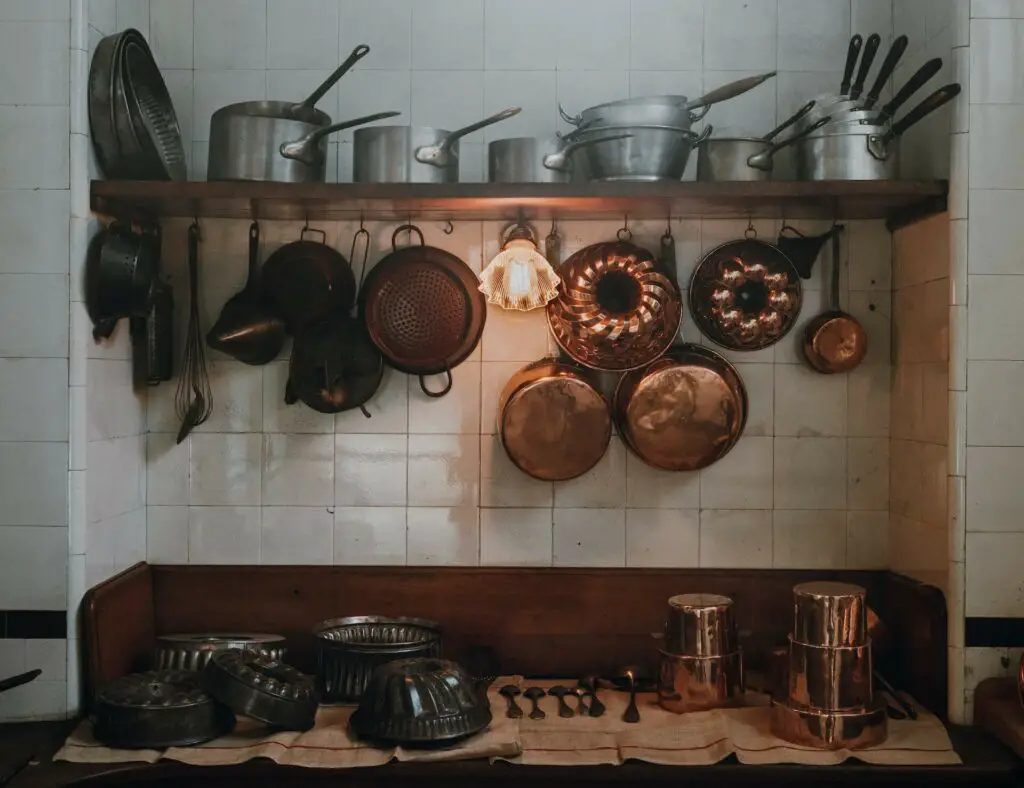
Head over to Lighting New York and check out their awesome selection of wall sconces! You’re sure to find the perfect kitchen sconces for you there. (Plotted Lights is affiliated with Lighting New York).
3. Don’t overdo it
Sconces are quite intense. They’re not as hidden as recessed can lights or LED strips and they’re not as expected as chandeliers or other major ambient fixtures.
This is why you need to be extra careful about the number of sconces you use and where you place them. An average-sized kitchen does not need more than 2-3 sconces, whether these are in sequence or dispersed.
Pro Tip: Do NOT use different kitchen sconces! That will look tacky and off-putting. Instead, choose the one style you like and buy 2-3 of that.
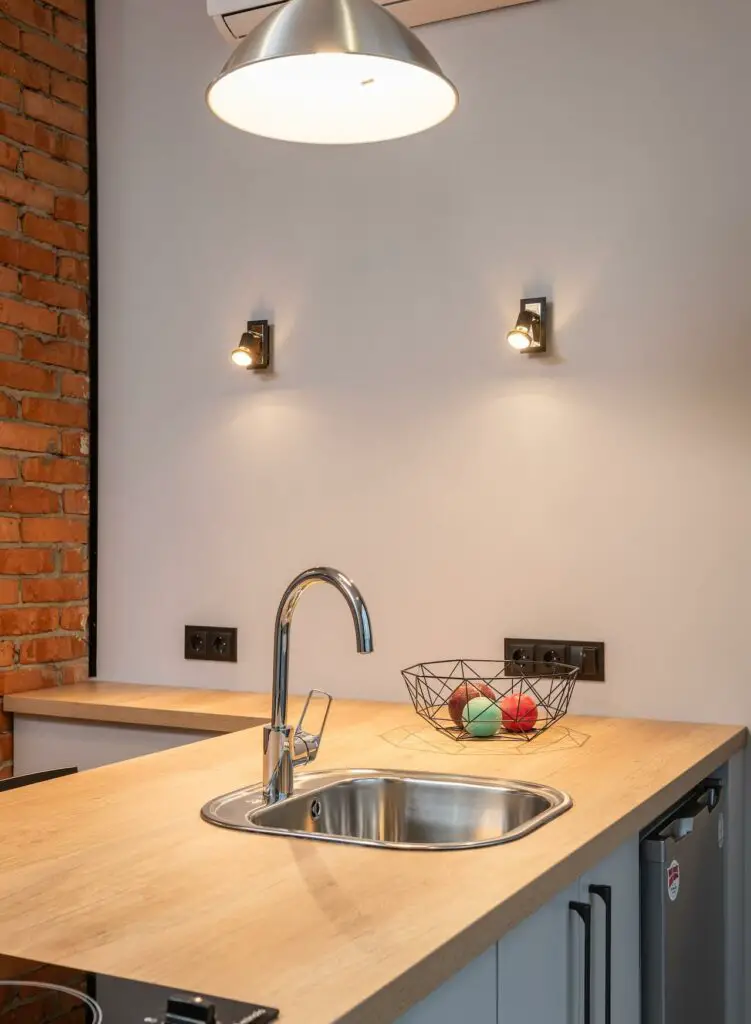
4. Sort your electrics
Our home lights should make our lives easier and more interesting. They should not be annoying or inconvenient.
Before you install your sconces, figure out if you want them all on the same switch or if you prefer individual switches for each one.
Don’t skip this step before buying the sconces because it truly is a lifesaver!
My suggestion is to use individual switches if each sconce has a different purpose and use the same switch if they are in sequence.
5. To dim or not to dim
That is the question. And to answer that question, you need to think of the following:
- What is the purpose of the sconces? Are they used for ambient light (usually uplighters), task lighting (usually downlighters), or both (360°)? For ambient or both, you can install dimmers so that you can create the perfect mood anytime you want. Task lighting, however, does not need dimmers as you only use it when…doing a task!
- How much control do you want over your lights? Do you enjoy playing with different mood lights and figuring out the perfect light combination for that particular time? If yes, then you definitely need dimmers (for your kitchen sconces and almost every other fixture in your home).
- What other activities are you doing in the kitchen? The kitchen is often called the heart of the home but people use it in many different ways. Do you just use the kitchen for cooking or also have dinner? What other activities are you doing in the kitchen? The more you use it, the more versatile you want your lighting to be!
So there you have it. Follow these 5 tips and your kitchen sconces will feel natural and look amazing!
Wrapping up
Kitchen sconces can be tricky. Sometimes they elevate a kitchen’s lighting scheme but sometimes they look out of place. If you decide to use them, remember the following:
- Define their purpose
- Based on that, decide their placement and distance between them
- Consider if they work well with your other fixtures
- Choose sconces based on your kitchen’s design. Don’t buy them if you are not sure they will look good in your kitchen.
- Add the final touches (if you want them dimmable, on the same switch, etc.)
Finally, check out how many lumens you need in each kitchen area, get the right bulbs, and you’re good to go!
